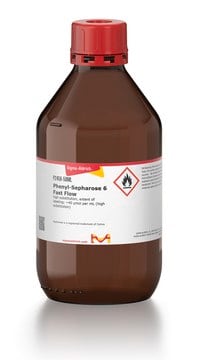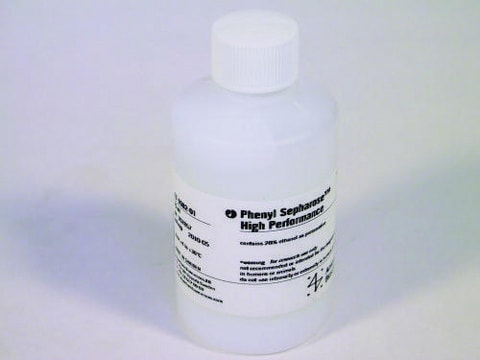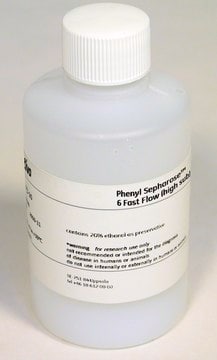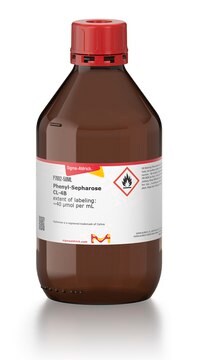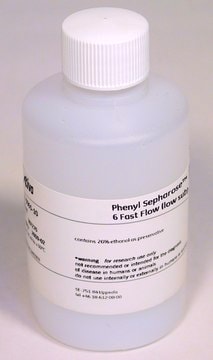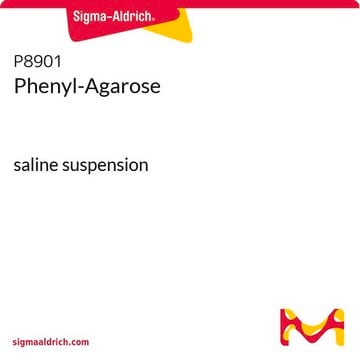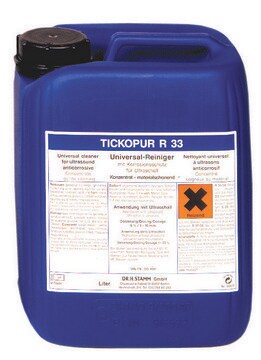P2334
Phenyl-Sepharose 6 Fast Flow
low substitution, extent of labeling: ~20 μmol per mL
Synonym(s):
Phenyl-Agarose
Sign Into View Organizational & Contract Pricing
All Photos(1)
About This Item
Recommended Products
form
suspension
extent of labeling
~20 μmol per mL
matrix
agarose, 6% crosslinked
matrix activation
epichlorohydrin
matrix attachment
ether
matrix spacer
3 atoms
particle size
45-165 μm
capacity
~14 mg/mL binding capacity (BSA)(lineal flow rate of 100 cm/hr)
storage temp.
2-8°C
Looking for similar products? Visit Product Comparison Guide
General description
P2334-200ml′s updated product number is GE17-0965-05
Application
Phenyl [YM="Sepharose"] is used in protein chromatography, affinity chromatography, hydrophobic interaction media, resins and separation media. Phenyl Sepharose™ has been used in studies that contributed to improving industrial applications in additives in detergents and feed industries. Phenyl sepharose has also been used to study microbial communities inhabiting hypersaline environments.
Physical form
Suspension in 20% ethanol
aqueous ethanol suspension
Legal Information
Sepharose is a trademark of Cytiva
replaced by
Product No.
Description
Pricing
Signal Word
Warning
Hazard Statements
Precautionary Statements
Hazard Classifications
Flam. Liq. 3
Storage Class Code
3 - Flammable liquids
WGK
WGK 3
Flash Point(F)
95.0 °F
Flash Point(C)
35 °C
Certificates of Analysis (COA)
Search for Certificates of Analysis (COA) by entering the products Lot/Batch Number. Lot and Batch Numbers can be found on a product’s label following the words ‘Lot’ or ‘Batch’.
Already Own This Product?
Find documentation for the products that you have recently purchased in the Document Library.
Customers Also Viewed
Agnes Marot-Leblond et al.
Journal of clinical microbiology, 44(1), 138-142 (2006-01-05)
Cell components of the dimorphic pathogenic fungus Candida dubliniensis were used to prepare monoclonal antibodies (MAbs). One MAb, designated 12F7-F2, was shown by indirect immunofluorescence to be specific for a surface antigen of Candida dubliniensis yeast cells. No reactivity was
J L Blank et al.
The Journal of biological chemistry, 268(33), 25184-25191 (1993-11-25)
We report the purification from bovine brain cytosol of a 110-kDa phosphoinositide-specific phospholipase C (PLC-110) that was markedly stimulated by G-protein beta gamma-subunits. The enzyme was purified approximately 2000-fold with a yield of 4%. On the basis of size and
P D Zschocke et al.
European journal of biochemistry, 213(1), 263-269 (1993-04-01)
A purification procedure for guanylate kinase from pig brain has been developed consisting of ammonium sulfate precipitation and heptane extraction of the crude extract, hydrophobic-interaction chromatography, affinity chromatography and chromatofocussing. From 1.75 kg pig brain, 1.2 mg enzyme was isolated
Simona Lobasso et al.
Photochemistry and photobiology, 88(3), 690-700 (2012-01-18)
We have isolated and characterized the light-driven proton pump Bop I from the ultrathin square archaeon Haloquadratum walsbyi, the most abundant component of the dense microbial community inhabiting hypersaline environments. The disruption of cells by hypo-osmotic shock yielded Bop I
Jace L Fogle et al.
Journal of chromatography. A, 1121(2), 209-218 (2006-05-13)
Amide hydrogen-deuterium exchange labeling has been used to study the effects of salt and protein loading on alpha-lactalbumin (BLA) stability during hydrophobic interaction chromatography (HIC). Stability in the adsorbed phase increased dramatically with increasing loading, and unfolding was nearly undetectable
Our team of scientists has experience in all areas of research including Life Science, Material Science, Chemical Synthesis, Chromatography, Analytical and many others.
Contact Technical Service